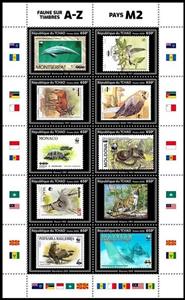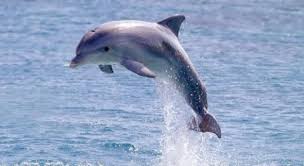Mini Sheet: Fauna on Stamps (Chad 2020)
Fauna on Stamps (Chad 2020)
30 May (Chad ) within release Stamps on Stamps (2020) goes into circulation Mini Sheet Fauna on Stamps face value 10*650 Central African CFA franc
| Mini Sheet Fauna on Stamps in catalogues | |
|---|---|
| Colnect codes: | Col: TD 2020-102 |
Mini Sheet is square format.
Although this issue was authorized by the Chad postal administration, it was not sold in Chad, but was only distributed by the Chad philatelic agency for distribution on the novelty market.Also in the issue Stamps on Stamps (2020):
- Mini Sheet - Fauna on Stamps face value 10*650;
- Mini Sheet - Fauna on Stamps face value 10*650;
- Souvenir Sheet - Bactrian Camel (Camelus bactrianus) face value 1,000;
- Souvenir Sheet - Pink Pigeon (Nesoenas mayeri) face value 1,000;
- Souvenir Sheet - Giant Clam (Tridacna gigas) face value 1,000;
- Souvenir Sheet - Mediterranean Monk Seal (Monachus monachus) face value 1,000;
- Souvenir Sheet - Giant Eland (Taurotragus derbianus) face value 1,000;
- Souvenir Sheet - Maldives Anemone Fish (Amphiprion nigripes) face value 1,000;
- Souvenir Sheet - Wattled Crane (Grus carunculata) face value 1,000;
- Souvenir Sheet - Ruffed Lemur (Lemur variegatus) face value 1,000;
- Souvenir Sheet - Monarch Butterfly (Danaus plexippus) face value 1,000;
- Souvenir Sheet - Micronesian Imperial Pigeon (Ducula oceanica) face value 1,000;
- Souvenir Sheet - Short Beaked Common Dolphin (Delphinus delphis) face value 1,000;
- Souvenir Sheet - Trocaz Pigeon (Columba trocaz) face value 1,000;
- Souvenir Sheet - Lichtenstein's Hartebeest (Alcelaphus lichtensteini) face value 1,000;
- Souvenir Sheet - Eleonora's Falcon (Falco eleonorae) face value 1,000;
- Souvenir Sheet - Hermann's Tortoise (Testudo hermanni) face value 1,000;
- Souvenir Sheet - Aesculapian Snake (Elaphe longissima) face value 1,000;
- Souvenir Sheet - Chinese Pangolin (Manis pentadactyla) face value 1,000;
- Souvenir Sheet - Clouded Leopard (Neofelis nebulosa) face value 1,000;
- Mini Sheet - Imperial Eagle (Aquila heliaca) face value 1,000;
- Souvenir Sheet - Spotted Eagle Ray (Aetobatus narinari) face value 1,000;
Mini Sheet Fauna on Stamps it reflects the thematic directions:
Animals are multicellular, eukaryotic organisms of the kingdom Animalia (also called Metazoa). All animals are motile, meaning they can move spontaneously and independently, at some point in their lives. Their body plan eventually becomes fixed as they develop, although some undergo a process of metamorphosis later on in their lives. All animals are heterotrophs: they must ingest other organisms or their products for sustenance.
The term antelope refers to numerous extant or recently extinct species of the ruminant artiodactyl family Bovidae that are indigenous to most of Africa, India, the Middle East, Central Asia, and a small area of Eastern Europe. Antelopes do not form a monophyletic group, as some antelopes are more closely related to other bovid groups, like bovines, goats, and sheep, than to other antelopes.
A better definition, also known as the "true antelopes", includes only the genera Gazella, Nanger, Eudorcas, and Antilope. One North American mammal, the pronghorn or "pronghorn antelope", is colloquially referred to as the "American antelope", despite the fact that it belongs to a completely different family (Antilocapridae) than the true Old-World antelopes; pronghorn are the sole extant member of an extinct prehistoric lineage that once included many unique species.
Birds (Aves), a subgroup of Reptiles, are the last living examples of Dinosaurs. They are a group of endothermic vertebrates, characterised by feathers, toothless beaked jaws, the laying of hard-shelled eggs, a high metabolic rate, a four-chambered heart, and a strong yet lightweight skeleton. Birds live worldwide and range in size from the 5 cm (2 in) bee hummingbird to the 2.75 m (9 ft) ostrich. They rank as the class of tetrapods with the most living species, at approximately ten thousand, with more than half of these being passerines, sometimes known as perching birds. Birds are the closest living relatives of crocodilians.
A dolphin is an aquatic mammal within the infraorder Cetacea. Dolphin species belong to the families Delphinidae (the oceanic dolphins), Platanistidae (the Indian river dolphins), Iniidae (the New World river dolphins), Pontoporiidae (the brackish dolphins), and possibly extinct Lipotidae (baiji or Chinese river dolphin). There are 40 extant species named as dolphins.
Parrots (Psittaciformes), also known as psittacines (/ˈsɪtəsaɪnz/), are birds with a strong curved beak, upright stance, and clawed feet. They are classified in four families that contain roughly 410 species in 101 genera, found mostly in tropical and subtropical regions. The four families are the Psittaculidae (Old World parrots), Psittacidae (African and New World parrots), Cacatuoidea (cockatoos), and Strigopidae (New Zealand parrots). One-third of all parrot species are threatened by extinction, with a higher aggregate extinction risk (IUCN Red List Index) than any other comparable bird group Parrots have a generally pantropical distribution with several species inhabiting temperate regions as well. The greatest diversity of parrots is in South America and Australasia
Turtles are reptiles of the order Testudines, characterized by a special shell developed mainly from their ribs. Modern turtles are divided into two major groups, the Pleurodira (side necked turtles) and Cryptodira (hidden necked turtles), which differ in the way the head retracts. There are 360 living and recently extinct species of turtles, including land-dwelling tortoises and freshwater terrapins. They are found on most continents, some islands and, in the case of sea turtles, much of the ocean. Like other amniotes (reptiles, birds, and mammals) they breathe air and do not lay eggs underwater, although many species live in or around water.






